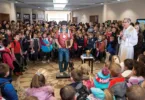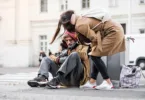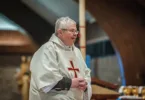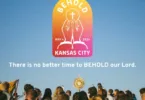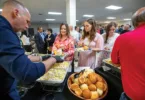Liturgy document resulted in far-reaching changes
by Joe Bollig
joe@theleaven.org
KANSAS CITY, Kan. — For our more seasoned archdiocesan pastors, the introduction of the new Roman Missal last year was like something New York Yankees legend Yogi Berra said: It’s déjà vu all over again.
They’ve been through it before. In fact, they experienced even greater changes thanks to the first great document produced by the Second Vatican Council.
That revolutionary document is the Constitution on the Sacred Liturgy, or “Sacrosanctum Concilium” (“Sacred Council”), which was promulgated on Dec. 4, 1963.
Today, most Catholics of the Latin Rite (the majority of Catholics in the archdiocese) don’t give the changes brought by “Sacrosanctum Concilium” a second thought.
In fact, many archdiocesan Catholics might not even be aware of the greatest change: language.
At one time, the Mass was celebrated in Latin, rather than in people’s everyday language — English for some, but for others, Spanish, Korean, Vietnamese, Tagalog (Filipino) and so on.
But language wasn’t the only change to the Mass. The Mass resulting from the Second Vatican Council (known as the Mass of Paul VI, Novus Ordo or Ordinary Form) featured:
• new eucharistic prayers and prefaces
• the simplification or omission of certain parts of the Mass
• an increased emphasis on the homily
• the introduction of an additional reading at Sunday Masses from the Old Testament
• the implementation of two new Scripture reading cycles, one each for Sunday and weekday Masses, which would incorporate readings from a much higher percentage of the Bible than in the past
• much greater participation by laypeople, who could now serve as cantors, lectors and extraordinary ministers of the Eucharist.
The council document dealt with the Mass, sacraments, sacramentals, the Divine Office, the liturgical year, the sacred art and furnishings inside the church, and music.
Msgr. Ray Burger, now retired and living in Overland Park, was ordained in 1960 — two years before the Second Vatican Council opened. “The words ‘liturgy’ and ‘liturgical’ were not common in the vocabulary of the parishioners or Catholics in general [before the council],” Msgr. Burger said. “We spoke of the Mass, baptism, confirmation and so on, but we did not speak of them as liturgy or liturgical acts.”
“Our main worship or liturgical act was the Mass,” he continued. “It was universally celebrated in Latin. The priest faced an altar on the back wall of the apse area of the church. An altar server made most of the responses to the priest and, again, in Latin.”
The stated aim of “Sacrosanctum Concilium” was the “full and active participation of all the people.” The Council Fathers were concerned that this was a weak area in the life of Catholics at that time.
“What were people in the pew doing?” said Msgr. Burger. “Some followed the Mass in a variety of missalettes. Others fingered their rosary beads. Most seemed to be spectators at an event taking place between a priest and his server, the priest periodically turning toward the congregation to say ‘Dominus vobiscum,’ or ‘The Lord be with you.’”
Father Larry Albertson, pastor of Queen of the Holy Rosary Parish in Wea/Bucyrus, was at Kenrick Seminary in St. Louis when the liturgical constitution was promulgated. He had an early taste of the new reforms before the average layperson experienced them.
“The [American] bishops decided we would start the changes at Advent,” said Father Albertson. “As soon as we got back from summer vacation [in 1964] at Kenrick Seminary, we started all the changes ourselves because Cardinal [Joseph] Ritter [of St. Louis] wanted some knowledge of how things would go and if there were some things they needed to look into that would be problems in the parishes. So we started with the English that was allowed in the liturgy right in September of 1964.”
A period of experimentation followed the promulgation of the liturgical constitution. One version mixed English responses of the people with the Latin prayers by the priest. An intermediate English language Mass was used from 1965 until the Mass of Paul VI came into effect for the First Sunday of Advent in 1969.
By this time, Msgr. Burger had been appointed director of liturgy for the archdiocese. He and members of the liturgical committee taught archdiocesan Catholics the new Paul VI Mass.
“The liturgical committee, at its first efforts, demonstrated the new Mass to a group of parishioners at an unnamed region,” he said.
“After the celebration,” continued Msgr. Burger, “in a question-and-answer period, the first comment that was made was this: ‘We’ve been doing this already for two months.’ Or another comment, ‘Why did you do such-and-such at the offertory? We do it this way,’ followed by a description. And, of course, in their mind, the liturgical committee — which demonstrated the new Mass as it was meant to be — was looked upon as the one in error.”
One of the most remarkable things about “Sacrosanctum Concilium” is that it is still relevant — still having an impact today. This can be seen in the adoption of the new Third Typical Edition of the Roman Missal in 2011 and the coming changes with a new Lectionary.
“Documents on the sacraments are continuing to make appropriate changes in them,” said Msgr. Burger. “Yes, the impact of the [Second Vatican] Council with this document has been massive.”
With their liturgical constitution, the Council Fathers have not “painted the church into a corner,” he said, but, “painted with such broad strokes as to make [it] meaningful in uncountable situations.”
Thus, “Sacrosanctum Concilium” continues to be implemented. Or as Yogi Berra would put it so elegantly, “It ain’t over till it’s over.”

